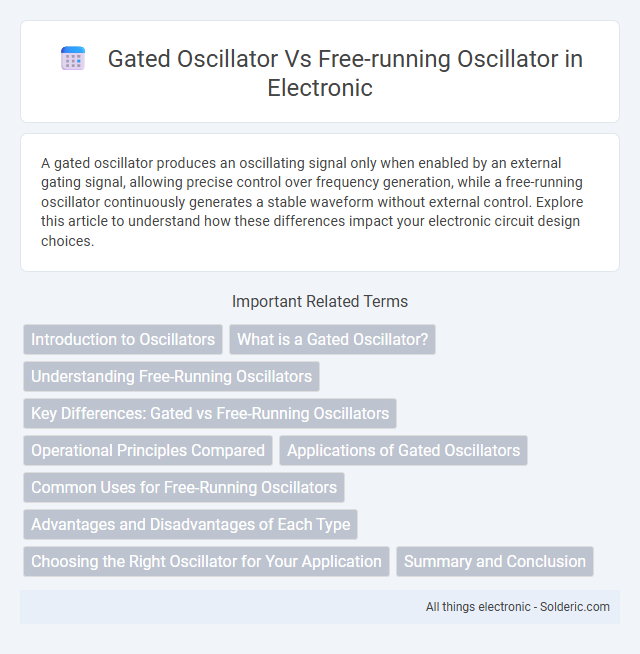A gated oscillator produces an oscillating signal only when enabled by an external gating signal, allowing precise control over frequency generation, while a free-running oscillator continuously generates a stable waveform without external control. Explore this article to understand how these differences impact your electronic circuit design choices.
Comparison Table
| Feature | Gated Oscillator | Free-Running Oscillator |
|---|---|---|
| Operation | Oscillation controlled by an external gate signal | Continuous oscillation without external control |
| Frequency Stability | Depends on gate signal timing and circuit design | Generally stable and fixed frequency |
| Applications | Frequency synthesis, pulse generation, time measurement | Clocks, signal generators, communication systems |
| Power Consumption | Lower, oscillates only when gated ON | Higher, continuous operation |
| Complexity | More complex due to gating circuitry | Simpler design |
| Output Control | Enabled or disabled by gate signal | Always active |
Introduction to Oscillators
Oscillators generate continuous waveforms used in various electronic applications, with gated oscillators producing signals only when a control input is active, enabling precise timing control. Free-running oscillators operate continuously without external gating, ideal for generating stable reference frequencies. Understanding Your needs for timing and signal control helps determine whether a gated or free-running oscillator suits your application best.
What is a Gated Oscillator?
A gated oscillator is an electronic oscillator whose output frequency or oscillation is controlled by an external gating signal, allowing the oscillator to start and stop oscillating on command. Unlike a free-running oscillator that continuously oscillates at a set frequency, a gated oscillator produces oscillations only when the gate input is active, providing precise timing control in digital circuits and signal processing. This gating mechanism makes gated oscillators essential in timing applications such as frequency synthesis, pulse generation, and synchronized signal modulation.
Understanding Free-Running Oscillators
Free-running oscillators generate continuous waveforms at a fixed frequency determined by their circuit components, such as inductors and capacitors, without external input control. In contrast, gated oscillators can start and stop oscillating based on gating signals, offering synchronization with other system events. Understanding free-running oscillators helps you design circuits requiring stable and uninterrupted frequency sources for applications like clocks, radios, and signal generators.
Key Differences: Gated vs Free-Running Oscillators
Gated oscillators operate by starting and stopping oscillations through an external gating signal, providing precise control over the output waveform duration, while free-running oscillators generate continuous oscillations without external control once energized. The primary distinction lies in the timing control: gated oscillators allow you to synchronize output with other circuit events, making them ideal for time-dependent applications, whereas free-running oscillators are suited for steady, uninterrupted signal generation. Design considerations also highlight power consumption differences, as gated oscillators consume power only when active, unlike free-running oscillators that continuously draw power during operation.
Operational Principles Compared
Gated oscillators operate by generating oscillations only when an external gating signal is applied, allowing precise control over waveform initiation and duration. Free-running oscillators continuously produce oscillations without external gating, relying solely on their internal feedback loop and frequency-determining components. Your choice between the two depends on whether controlled activation (gated oscillator) or continuous waveform generation (free-running oscillator) best suits your application's timing and signal requirements.
Applications of Gated Oscillators
Gated oscillators are commonly used in timing and synchronization applications where precise control over oscillation duration is critical, such as in pulse generation, frequency modulation, and digital clock gating. Free-running oscillators, by contrast, are suited for continuous signal generation in radio transmitters, local oscillators, and waveform synthesis where uninterrupted oscillation is necessary. Your choice between gated and free-running oscillators should depend on whether you require controlled bursts of oscillation or stable continuous waveforms.
Common Uses for Free-Running Oscillators
Free-running oscillators are widely used in applications requiring continuous, stable frequency generation, such as clock signals in digital circuits and carrier waves in communication systems. These oscillators maintain oscillation without external gating or control, making them ideal for timing references and signal generation in radios, audio equipment, and waveform generators. Your circuits benefit from their reliable frequency output in environments where uninterrupted operation is essential.
Advantages and Disadvantages of Each Type
Gated oscillators offer precise frequency control and rapid start-stop capabilities, making them ideal for timing and pulse applications, but they often suffer from increased phase noise and complexity. Free-running oscillators provide stable oscillation with simpler design and lower phase noise, yet lack immediate frequency control and can drift due to environmental factors like temperature and supply voltage variations. Understanding these trade-offs helps designers select the appropriate oscillator type for applications requiring either controlled gating or continuous frequency stability.
Choosing the Right Oscillator for Your Application
Gated oscillators generate output signals controlled by an external gating signal, making them ideal for timing-sensitive applications such as pulse generation and modulation. Free-running oscillators continuously produce a stable frequency without external control, suited for applications requiring consistent oscillations like clock generation or RF signal sources. Your choice depends on whether you need controlled activation with precise timing (gated oscillator) or continuous, stable frequency output (free-running oscillator).
Summary and Conclusion
Gated oscillators offer precise control over signal generation by enabling oscillation only during specific intervals, which reduces power consumption and improves timing accuracy. Free-running oscillators continuously produce a stable frequency without external gating, making them suitable for applications requiring constant oscillation. Your choice depends on whether intermittent control or continuous output best fits your design requirements.
gated oscillator vs free-running oscillator Infographic

 solderic.com
solderic.com